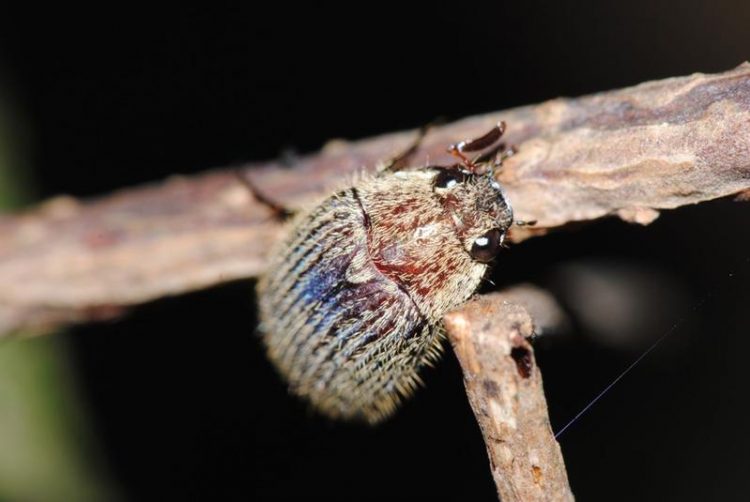Mini-Cockchafers reveal threatening fragmentation of South African Forests

Male beetle of Pleophylla silvatica searching for a mate. This species was newly discovered and described during the work on this publication. Copyright: D. Ahrens, ZFMK Bonn
However, the analyses also revealed areas that connect or that might connect today’s beetle populations most effectively. These areas should thus be considered for high priority conservation.
Natural indigenous forests are rarely found in South Africa. They only cover 0.6% of the countries area and only survived in protected gorges and on mountain slopes. Among others, this is due to fires which are utilized to retain farmland but also to preserve the likewise ecologically valuable grassland and the typical South African fynbos (“fine bush”) vegetation.
Despite their small extent these forests hold a rich flora and fauna, constituted of species that only occur there. This is also attributed to southern African climate which was relatively stable over long evolutionary time scales compared to other regions in the world. Also, a complex variety of small-scale local climates facilitated today’s biological diversity. Since this is true for forests as well as for other vegetation forms, there are ongoing debates on the natural extent of the threatened South African forest remains.
A study about forest-associated mini-cockchafers that was recently published by researchers at the Zoological Research Museum A. Koenig in the scientific journal Global Change Biology, now suggests a larger potential natural extent of indigenous forest than currently believed.
Because beetles of the genus Pleophylla exclusively occur in forests and their larvae and adults are not restricted to specific plant species, their occurrence can be assumed representative for the forests distribution. Models based on currently known occurrences of the beetles and suitable climate showed that a much wider extent of forests would be possible and thus support previous similar findings of other researchers.
Projecting the models back to past climate revealed that South African forests naturally increased and decreased several times since the last glacial. Under certain conditions these fluctuations could even help to explain the enormous species richness found in South Africa, which might in some cases be the result of repeated isolation of populations.
However, the current minimum of forest cover is threatening, because human activities like fire and forestry impede the forest’s natural expansion. The high degree of fragmentation pushes many species to their maximum dispersal capacity, so that there are already isolated populations. This is confirmed by climate-model-based connectivity analyses as well as genetic data of the investigated beetles.
Further diminution of forests or the eradication of stepping stone populations might thus lead to genetic impoverishment or extinction of many populations. The insights of the researchers from Bonn can be seen as a first step to a sustainable conservation of the threatened South African forest fauna in accordance with other valuable land forms, since they show concrete corridors that are well suited for efficient afforestation and high priority conservation of forest patches.
Contact:
Dr. Dirk Ahrens
Zoological Research Museum Alexander Koenig – Leibniz-Institute for Animal Biodiversity
Adenauerallee 160, 53113 Bonn
Phone: +49 228 9122 286
E-mail: d.ahrens@leibniz-zfmk.de
Original publication:
Eberle, J., Rödder, D., Beckett, M., and Ahrens, D. (2017) Landscape genetics indicate recently increased habitat fragmentation in African forest-associated chafers. Global Change Biology (2017), doi: 10.1111/gcb.13616
http://onlinelibrary.wiley.com/doi/10.1111/gcb.13616/abstract
Zoological Research Museum Alexander Koenig – Leibniz-Institute for Animal Biodiversity (ZFMK) is an independent research institute. The focus of research is on performing an inventory of the zoological species diversity on earth, on the analysis of changes in biodiversity as a result of environmental factors, and on evolutionary processes at the morphological and molecular levels. ZFMK furthermore explores the context of structure and function of ecological systems, advanced scientific methods, and the study of the history of science. The permanent exhibition “Our blue planet – the living network” offers a genuine nature experience based on naturalistic ecosystem displays.
The Leibniz Association is a network of 91 scientifically, legally, and economically independent research institutes and scientific service facilities. Leibniz Institutes perform strategic and thematically-oriented research and offer scientific service of national significance while striving to find scientific solutions for major social challenges.
Media Contact
More Information:
http://www.zfmk.deAll latest news from the category: Life Sciences and Chemistry
Articles and reports from the Life Sciences and chemistry area deal with applied and basic research into modern biology, chemistry and human medicine.
Valuable information can be found on a range of life sciences fields including bacteriology, biochemistry, bionics, bioinformatics, biophysics, biotechnology, genetics, geobotany, human biology, marine biology, microbiology, molecular biology, cellular biology, zoology, bioinorganic chemistry, microchemistry and environmental chemistry.
Newest articles

Pinpointing hydrogen isotopes in titanium hydride nanofilms
Although it is the smallest and lightest atom, hydrogen can have a big impact by infiltrating other materials and affecting their properties, such as superconductivity and metal-insulator-transitions. Now, researchers from…

A new way of entangling light and sound
For a wide variety of emerging quantum technologies, such as secure quantum communications and quantum computing, quantum entanglement is a prerequisite. Scientists at the Max-Planck-Institute for the Science of Light…

Telescope for NASA’s Roman Mission complete, delivered to Goddard
NASA’s Nancy Grace Roman Space Telescope is one giant step closer to unlocking the mysteries of the universe. The mission has now received its final major delivery: the Optical Telescope…



